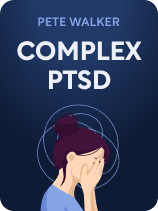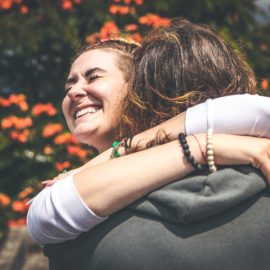

This article is an excerpt from the Shortform book guide to "Complex PTSD" by Pete Walker. Shortform has the world's best summaries and analyses of books you should be reading.
Like this article? Sign up for a free trial here.
How is Complex PTSD different from PTSD? How does specialist Pete Walker describe the nature of Complex PTSD?
Complex PTSD, Pete Walker’s book, describes a disorder caused by repeated traumatic experiences, like in the case of chronic child abuse or neglect. By looking at how CPTSD develops, you can clearly see the impacts of abuse and learn how to heal from it.
Read on to learn more about how trauma impacts the brain in cases of abuse.
Complex PTSD: From Surviving to Thriving
Pete Walker’s Complex PTSD is a guide to recognizing Complex Post-Traumatic Stress Disorder—which is more common than many people think—and beginning to recover from it. In this book on CPTSD, Walker provides detailed explanations of the disorder’s causes and symptoms, as well as numerous tips and tools to help people overcome their past traumas. Complex PTSD is written for people who suffer from it personally, but it’s also helpful for anyone who wants to understand the condition better.
Walker is a practicing psychotherapist with degrees in psychology and social work. In addition to his decades of practical experience, he’s worked as a writer and educator for more than 30 years, and as a therapists’ consultant for 20 years. Walker is also a childhood trauma survivor and draws upon his own experiences for his books. Complex PTSD is Walker’s second and most popular book; the author also recommends reading The Tao of Fully Feeling (his first book) as a supplement, since it goes into greater detail about some of the topics covered in Complex PTSD.
Our guide will begin by explaining what complex PTSD is—why and how it happens, as well as some of the most common symptoms. Next, we’ll go into detail about the various aspects of recovering from complex PTSD: physical, psychological, emotional, and social healing. Finally, we’ll discuss one crucial tip that Walker gives to help people on their recovery journey (embracing adequacy instead of fighting for perfection), and why that tip in particular is so important to someone who’s trying to heal from complex PTSD.
Our commentary provides additional information about psychology and trauma, as well as actionable advice for people who want to start their recovery journey or help a loved one with theirs. We’ll also compare and contrast Walker’s ideas with those from other psychology self-help books such as Why Does He Do That?.
What Is Complex PTSD?
Complex PTSD is short for Complex Post-Traumatic Stress Disorder; for brevity’s sake, we’ll refer to it as CPTSD from here on.
Walker explains that CPTSD is a psychological condition that comes from prolonged, repeated abuse or neglect, usually in childhood. He adds that while many people associate this condition with physical or sexual abuse, people can also develop CPTSD from verbal and emotional abuse, or even emotional neglect. He adds that CPTSD resulting from a long-term pattern of mistreatment separates it from the more commonly known form of PTSD, which can happen after a single traumatic experience.
Physically Recovering From CPTSD
Walker says that when dealing with complex trauma, recovery is also complex; it must address the physical, psychological, emotional, and social harm that long-term abuse or neglect causes. We’ll begin by discussing the physical aspects of recovery.
In addition to any long-term injuries a survivor might have from physical abuse, chronic stress from CPTSD can cause severe ongoing damage to their body. For instance, constantly being tense can injure their muscles, or insomnia can weaken their immune systems and make them heal more slowly; in many cases, survivors also harm themselves even more by self-medicating with alcohol or other drugs.
Helping Your Body Repair Itself
Walker says the good news about physical trauma is that the human body is very good at fixing itself. Therefore, by treating and managing their condition, people with CPTSD will heal from this damage naturally.
To speed the healing process, Walker suggests taking classes in a practice that promotes relaxation—meditation, for instance—or improves flexibility, such as Tai Chi. This helps because by reducing stress and loosening their muscles, people with CPTSD can minimize further damage to their bodies and give themselves the chance to recover.
Psychologically Recovering From CPTSD
Healing from the physical damage of trauma is an important step toward feeling better, but most of the effects of CPTSD are mental and emotional. Therefore, it’s equally important to learn the psychological symptoms of trauma and how to start recovering from them.
Walker explains that complex trauma often leaves survivors with a distorted sense of self; they internalize the hurtful things their abusers said and come to believe them. For instance, someone who grew up being told that they’re stupid likely still believes it, even if there’s plenty of evidence to the contrary in their accomplishments.
(Shortform note: According to many psychologists, self-underestimation—undervaluing one’s own worth, as Walker describes here—is a common result of childhood neglect or abuse. Some parents actively harm their children’s self-esteem by insulting and belittling them (abuse). However, neglect can lead to the same result; young children often believe their parents are infallible, and therefore a neglected child will conclude that they (the child) must not deserve to be loved, rather than recognizing that their parents are in the wrong.)
In this section, we’ll examine two key parts of recovering from the psychological damage of complex trauma: reducing the tendency to blame and harshly criticize oneself and developing a sense of self-love and compassion.
Placing Blame Where It Belongs
Because victim-blaming causes so much harm to the survivor, Walker says that psychological recovery begins with the survivor learning to place the blame for their trauma where it belongs: on their abusers. Doing so helps them start to break out of the habit of blaming and shaming themselves.
While the recovery process for people with CPTSD often begins with learning to assign blame for their past traumas specifically, appropriately placing blame is a crucial skill that they’ll need to continue to practice throughout their lives. Survivors who don’t learn this skill might spend their whole lives reenacting the abuse they suffered: They’ll berate and criticize themselves for anything that’s less than perfect, regardless of how important it is or whether it’s even their fault. Anything from their physical appearance to minor mistakes can trigger a survivor into self-blame and virulent shame.
Developing Self-Awareness and Self-Acceptance
Because shame and perfectionism are major symptoms of CPTSD, an important part of recovery is to develop a healthy sense of self, writes Walker. In other words, people with CPTSD need to learn—or relearn—how to identify their needs and ensure those needs are met.
This is necessary because a common abuse tactic is to shame or frighten the victim out of their self-loving and self-protective feelings. For example, an abusive spouse might call their partner selfish for expressing personal needs and wants; an abusive parent might hit their children for trying to stand up for themselves. Eventually, the victim learns that the only way to stay (relatively) safe is to always put their abuser’s desires before their own.
Emotionally Recovering From CPTSD
Healing from the psychological impacts of trauma is a large part of recovery. However, for a survivor to fully develop or regain their sense of self, they must also reconnect with the emotions that their abusers forced them to repress.
Walker says that abusers often punish and shame their victims for expressing negative emotions like sadness or anger. As a result, trauma survivors tend to repress those feelings, which can cause two serious problems:
First, trying to avoid unpleasant or “forbidden” emotions makes people unable to process those feelings and move on from them. Therefore, paradoxically, people who try to avoid feeling negative emotions often get stuck in negative emotional states for a much longer time. To illustrate this idea, picture negative feelings like a so-called Chinese finger trap: The harder someone struggles to escape, the more tightly the negative feelings hold them.
(Shortform note: The effects of repressing emotions can be much more severe than just feeling worse for a longer time—those unprocessed feelings keep accumulating, eventually becoming a source of intense stress and even psychiatric disorders like anxiety and depression. Emotionally repressed people also tend to have a hard time forming meaningful relationships; they’re not able to be open and honest about their own feelings, and they’re often uncomfortable when people express strong emotions. As a result, they form only shallow and distant connections with others, rather than creating meaningful and supportive relationships.)
Second, repressing some emotions often leads to repressing all emotions. In other words, in trying to avoid feeling sad or angry, the survivor becomes unable to feel anything. This leaves them unable to enjoy the good things in life, and often makes it difficult for them to make even simple decisions; without emotions guiding them, they don’t know what they want.
This emotional deadening is also a safety concern because negative emotions are clues that something’s wrong. Therefore, without feelings like fear and anger to warn them of potential problems, the survivor may not be able to recognize when they’re in danger or are being treated unfairly.
Reconnecting With Emotions Through Grief
Walker says that overcoming the emotional damage of CPTSD requires the survivor to reconnect with their feelings through grief. Grieving is a powerful experience that involves the full range of emotions—negative feelings like sorrow, as well as positive feelings like acceptance and hope for the future—and therefore it’s ideal for helping people break through emotional barriers.
(Shortform note: Although safe and long-term recovery from CPTSD requires therapy, there are other ways for people to try reconnecting with their feelings. For instance, some mental health professionals suggest using books and movies to spark feelings of joy or grief. Fiction has the added benefit of being a relatively safe emotional outlet for survivors who aren’t ready to confront their own experiences yet.)
Grieving is also an important part of working through traumatic experiences and, eventually, recovering from them. Walker explains that complex trauma survivors often need to grieve for the lost parts of their lives: for example, the love and safety they should have experienced, the feelings they should have been allowed to express, or the self-esteem they should have been encouraged to develop.
Socially Recovering From CPTSD
The previous sections have focused on trauma survivors as individuals, but Walker says that another crucial part of recovering from CPTSD is learning how to form healthy relationships. This is necessary because people have deep-seated needs to feel safe and loved, and the only way to meet those needs is through meaningful connections with other people. He adds that “safe” in this context doesn’t just mean physically safe, but also safe to be fully themselves: to freely express their thoughts and feelings without the fear of ridicule or punishment.
Remember that CPTSD occurs when the most important people in someone’s life—such as family members or romantic partners—habitually abuse and neglect that person. This conditions the survivor to believe that all people are dangerous: If they couldn’t trust the people they were closest to, who could they possibly trust now?
Finding Meaningful Connections
The importance of strong social bonds is well documented and widely accepted, but how can someone who believes people are dangerous start to form deep, meaningful, supportive relationships with others?
Walker says that, in many cases, a survivor’s first meaningful connection is with their therapist. When someone’s conditioned to be afraid of others, sharing personal details and leaving themselves emotionally vulnerable feels much too dangerous to risk. Therefore, therapy may be the first time they’re able to talk honestly about their thoughts, feelings, and past experiences.
Trauma support groups or online forums about recovery are also good places for someone with CPTSD to begin looking for healthy connections with other people. For survivors who aren’t ready to join new social groups, a pet can also be an excellent source of love, acceptance, and connection.
Tip for Healing: Embrace the Adequate
Walker provides numerous tips and tools to help survivors with their CPTSD, but the one he emphasizes most is embracing the adequate: accepting and appreciating things that are “good enough,” instead of throwing them away to look for something perfect. For example, breaking contact with a friend just because they have an annoying habit often does more harm than good. Similarly, leaving a good doctor over a single mistake might leave someone scrambling to find another provider whom they trust.
Therapists commonly encourage embracing the adequate to preserve important and beneficial relationships, even if they’re not perfect, as in the above examples. However, Walker believes that people should try to apply that mindset to every aspect of their lives: an adequate home, an adequate career, an adequate meal, an adequate vacation, and so on.

———End of Preview———
Like what you just read? Read the rest of the world's best book summary and analysis of Pete Walker's "Complex PTSD" at Shortform.
Here's what you'll find in our full Complex PTSD summary:
- A guide to recognizing Complex Post-Traumatic Stress Disorder
- How to recover using physical, psychological, emotional, and social healing
- Why it's so important to accept and appreciate things that are "good enough"






